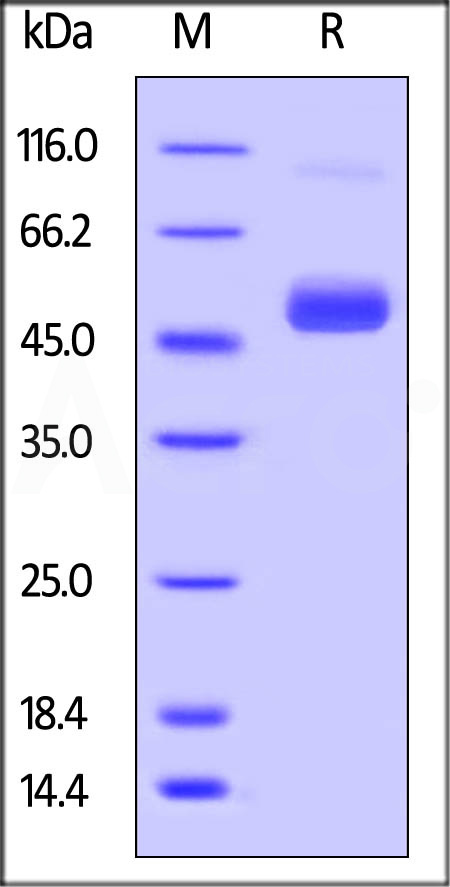分子别名(Synonym)
Non-structural Protein/NS1 (ZIKV)
表达区间及表达系统(Source)
Biotinylated Zika virus NS1, Avitag,His Tag (NS1-Z82E9) is expressed from human 293 cells (HEK293). It contains AA Val 796 - Ser 1148 (Accession # ALU33341.1).
Predicted N-terminus: Val 796
Request for sequence
蛋白结构(Molecular Characterization)

This protein carries an Avi tag (Avitag™) at the C-terminus, followed by a polyhistidine tag.
The protein has a calculated MW of 43.3 kDa. The protein migrates as 46-50 kDa under reducing (R) condition (SDS-PAGE) due to glycosylation.
标记(Labeling)
Biotinylation of this product is performed using Avitag™ technology. Briefly, the single lysine residue in the Avitag is enzymatically labeled with biotin.
蛋白标记度(Protein Ratio)
Passed as determined by the HABA assay / binding ELISA.
内毒素(Endotoxin)
Less than 1.0 EU per μg by the LAL method.
纯度(Purity)
>90% as determined by SDS-PAGE.
制剂(Formulation)
Lyophilized from 0.22 μm filtered solution in PBS, pH7.4 with trehalose as protectant.
Contact us for customized product form or formulation.
重构方法(Reconstitution)
Please see Certificate of Analysis for specific instructions.
For best performance, we strongly recommend you to follow the reconstitution protocol provided in the CoA.
存储(Storage)
For long term storage, the product should be stored at lyophilized state at -20°C or lower.
Please avoid repeated freeze-thaw cycles.
This product is stable after storage at:
- -20°C to -70°C for 12 months in lyophilized state;
- -70°C for 3 months under sterile conditions after reconstitution.
电泳(SDS-PAGE)

Biotinylated Zika virus NS1, Avitag,His Tag on SDS-PAGE under reducing (R) condition. The gel was stained with Coomassie Blue. The purity of the protein is greater than 90%.
背景(Background)
Zika virus (ZIKV) is a member of the virus family Flaviviridae and the genus Flavivirus, transmitted by daytime-active Aedes mosquitoes, such as A. aegypti and A. albopictus. Its name comes from the Zika Forest of Uganda, where the virus was first isolated in 1947. Zika virus is related to dengue, yellow fever, Japanese encephalitis, and West Nile viruses. The infection, known as Zika fever, often causes no or only mild symptoms, similar to a mild form of dengue fever. It is treated by rest. Since the 1950s, it has been known to occur within a narrow equatorial belt from Africa to Asia. As of 2016, the illness cannot be prevented by drugs or vaccines. As of February 2016, there is evidence that Zika fever in pregnant women is associated with abnormal brain development in their fetuses through mother-to-child transmission of the virus, which may result in miscarriage or microcephaly.























































 膜杰作
膜杰作 Star Staining
Star Staining











